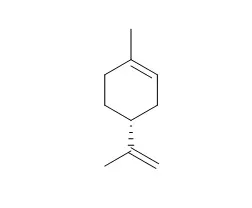| In vivo: |
| Nutritional Neuroscience, 2015, 18(5):217-224. | | Antihyperalgesic and antidepressive actions of (R)-(+)-limonene, α-phellandrene, and essential oil from Schinus terebinthifolius fruits in a neuropathic pain model.[Reference: WebLink] | Previous studies have shown that essential oil containing (R)-(+)-Limonene and α-phellandrene, extracted from fruits of Schinus terebinthifolius Raddi, exhibit anti-inflammatory activity.
METHODS AND RESULTS:
This work aimed to verify the antihyperalgesic and antidepressive actions of (R)-(+)-Limonene, α-phellandrene, and essential oil from S. terebinthifolius fruits in spared nerve injury (SNI) model of neuropathic pain in rats.In the present work, essential oil from fruits of S. terebinthifolius, as well as the pure (R)-(+)-Limonene and α-phellandrene compounds, were assayed for their effects on SNI-induced mechanical and cold hyperalgesia, and depressive-like behavior (immobility in forced swim test) in rats. The locomotor activity was evaluated in open-field test.Oral administration for up to 15 days of essential oil of S. terebinthifolius (100 mg/kg), (R)-(+)-Limonene (10 mg/kg), α-phellandrene (10 mg/kg), and also subcutaneous 10 mg/kg dose of ketamine (positive control) significantly inhibited SNI-induced mechanical hyperalgesia and increased immobility in the forced swim test. On the 15th day of oral treatment, α-phellandrene, but neither the essential oil from S. terebinthifolius nor (R)-(+)-Limonene, prevented the SNI-induced increase in sensitivity to a cold stimulus. The oral treatment with essential oil (100 mg/kg) or with compounds (10 mg/kg) did not interfere on locomotor activity.
CONCLUSIONS:
Together, the results of the present work show that essential oil of S. terebinthifolius and compounds present in this oil, including (R)-(+)-Limonene and α-phellandrene, exhibit antihyperalgesic effects against mechanical hyperalgesia, and are antidepressive, while only α-phellandrene inhibited cold hyperalgesia in SNI rats. |
|






 Cell. 2018 Jan 11;172(1-2):249-261.e12. doi: 10.1016/j.cell.2017.12.019.IF=36.216(2019)
Cell. 2018 Jan 11;172(1-2):249-261.e12. doi: 10.1016/j.cell.2017.12.019.IF=36.216(2019) Cell Metab. 2020 Mar 3;31(3):534-548.e5. doi: 10.1016/j.cmet.2020.01.002.IF=22.415(2019)
Cell Metab. 2020 Mar 3;31(3):534-548.e5. doi: 10.1016/j.cmet.2020.01.002.IF=22.415(2019) Mol Cell. 2017 Nov 16;68(4):673-685.e6. doi: 10.1016/j.molcel.2017.10.022.IF=14.548(2019)
Mol Cell. 2017 Nov 16;68(4):673-685.e6. doi: 10.1016/j.molcel.2017.10.022.IF=14.548(2019)